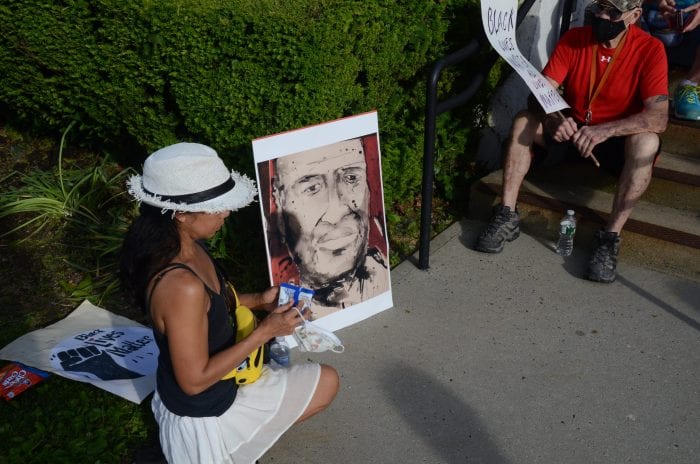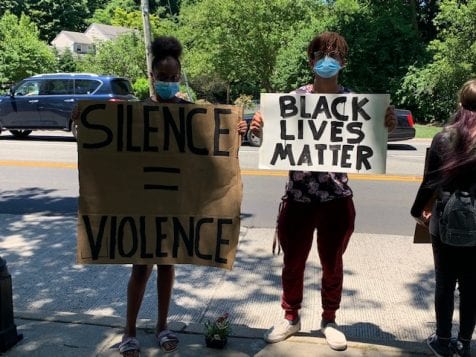From restaurants to retail stores to hair salons and barbers, business owners are all dealing with the same thing — how to open their doors while keeping their employees and customers safe.

Last Wednesday, June 10, Long Island entered Phase 2 of New York Forward. This phase allows restaurants to offer outdoor dining, stores to permit a limited number of customers inside and for hairdressers and barbers to finally open up shop again.
Marios Patatinis, who owns Sweet Mama’s in Northport and Stony Brook, said being able to offer outdoor dining on the restaurants’ patios has been helpful to increase business. He also bought The Bench Bar and Grill across from the Stony Brook train station right before the mandatory shutdowns. At this location he said outdoor dining is available in the parking lot, and he has been able to start renovations on the building.
The restaurant owner said he was happy to see customers able to stay, sit and enjoy their meals.
“Everyone is eager to get out of their own house and come out to eat again,” he said. “It’s nice to see people come out and socialize and mingle a bit.”
Patatinis said employees both in the front and back of the establishments are required to wear masks. Anyone who has direct contact with food will also wear gloves. Like other businesses, cleaning will be done more frequently, hand sanitizers will be made available for customers and one-time use menus will be handed out.
Patatinis said he’s looking forward to Phase 3, which will allow restaurants to offer indoor dining as long as occupancy stays at 50 percent or less than usual. During the pandemic and mandatory shutdowns, he said he was grateful that he was able to offer curbside takeout service to his customers.
“When you build a clientele, they become family,” he said.
Hairdressers have also been taking measures to serve customers while taking extra precautions, following guidelines from New York State. At Capelli hair salon in Nesconset, owned by Maria LaMariana, in addition to more cleaning protocols, when clients arrive they must text their hairdresser as the waiting room is temporarily closed. All customers and staff members wear behind-the-ear face masks, and clients have their temperature taken at the door and put on a disposable cape. The number of patrons in the salon is also limited, and people are asked not to bring anyone with them during their visit.
LaMariana said she also has customers fill out a form to verify that they aren’t sick and also to provide their phone number. The owner said this way if they get a call that anyone tested positive for the coronavirus, they will be able to contact quickly others that were in the salon that same day.
She said at first reopening was overwhelming, comparing it to going back to school, and she said she cried a couple of times. The owner, who has been cutting hair for 50 years, was nervous that customers would challenge why certain things were being done, but only one person gave her
a problem.
“I’m happy that people are very cooperative,” she said. “They come in, they clean their hands, we take their temperature, and they fill out the form.”

For the time being, LaMariana said she will be working seven days a week to catch up for the time lost during the pandemic and the limited capacity she is working with now. It was emotional to see her regulars again, she added, and one customer even left flowers outside the door the first day of the reopening.
“I never felt so important in my life,” she said. “I felt more important than a surgeon.”
Carolynn Mertens, director of stores and buyer for Madison’s Niche in Stony Brook Village Center, Sayville, Huntington and Garden City, said during the pandemic the store’s website was a big help where both regular customers and new ones across the country purchased items. Once Phase 1 began and stores were able to offer curbside service, Mertens said many customers ordered online and then picked up the merchandise themselves.
“But nothing compares to losing three months of in-store business, you can never make that up,” she said.
Mertens said in-store shopping is now allowed at 25 percent capacity. Customers and employees must maintain social distancing and wear a mask.
“People have been so respectful of each other and giving each other space shopping,” she said. “I think people are just generally excited to get out and enjoy the store, and get back to normal life.”
Employees have been busy sanitizing and cleaning commonly touched surfaces, such as door handles, keypads and phones, Mertens said. The stores are also making hand sanitizer available to customers and even selling masks. Clothes that are tried on in the dressing room will be quarantined by keeping them on a rack for a few days before they are returned to the sales floor.
Despite all the changes, she said it’s been wonderful seeing the customers again.
“When we reopened, it felt like Christmas,” Mertens said. “It was so energetic and lively.”
She said the staff was happy to hear many customers missed coming to the store, and reopening day was a successful one.
“It was a beautiful day,” she said. “We had the doors open. We had the music pumping. It was like a rebirth.”




















